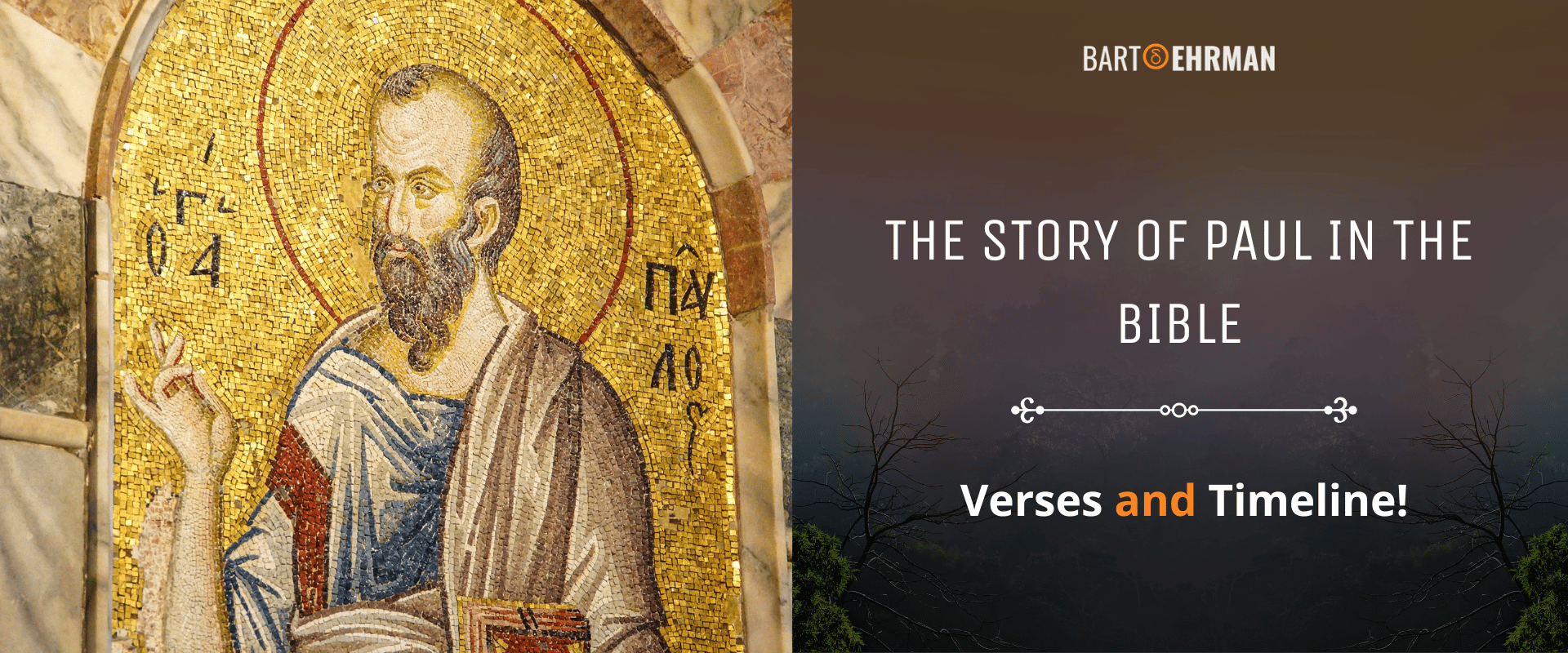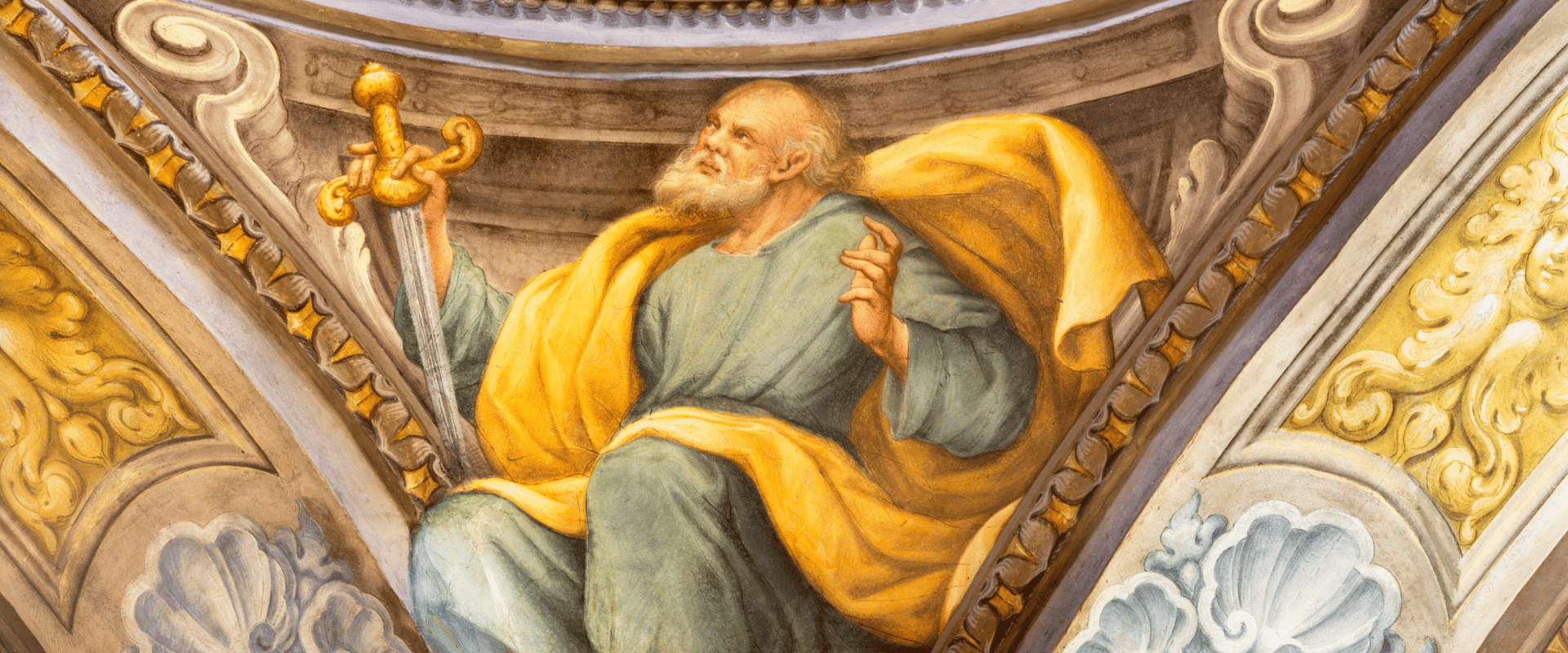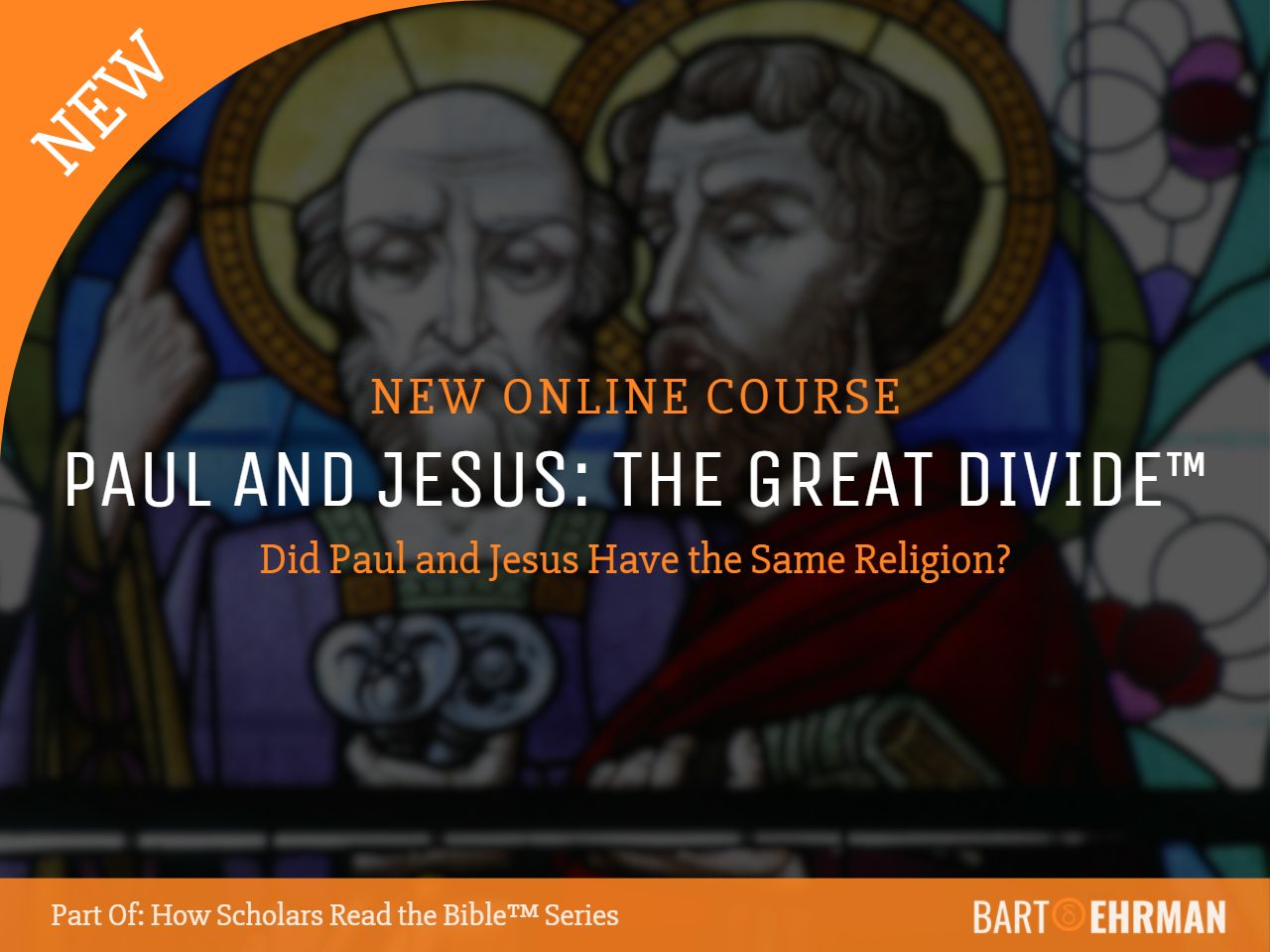The Story of Paul in the Bible (Verses & Timeline!)

Written by Joshua Schachterle, Ph.D
Author | Professor | Scholar
Author | Professor | BE Contributor
Verified! See our editorial guidelines
Verified! See our guidelines
Date written: April 19th, 2024
Disclaimer: The views and opinions expressed in this article belong to the author and do not necessarily match my own. - Dr. Bart D. Ehrman
When reading the New Testament, we first learn about a man named Saul in the book of Acts who oversees the execution of a man named Stephen, the first Christian martyr. In fact, we learn that this same Saul is seeking to destroy the church. But what happened next changed Saul’s life forever - and Christian history! He converted to Christianity, changed his name to Paul, and became the most important missionary for the Christian church ever. In this article, I will relay the story of Paul in the Bible from his early years, to his conversion, to his subsequent missionary journeys.
Karl Paul Donfried notes that telling Paul’s story is a difficult task for one principal reason:
The primary intention of the Gospels and other [New Testament] writings is not historical or biographical – they are documents of faith intended to proclaim, teach, and encourage the various early Christian communities.
While this is of course true, by using Paul’s letters combined with the book of Acts, we can trace with reasonable certainty the story of Paul’s life and his vast travels in the 1st century CE. Below is a timeline, based on one compiled by David E. Graves, of events in Paul’s life.
Take a look at it, then read on to look a bit closer at some of the most significant events of the story of Paul in the Bible. I’ll also include some of the verses in the Bible in which Paul’s story is found.

Timeline of Paul’s Life
Year CE | Event |
|---|---|
33-36 | Paul’s conversion/calling in Damascus (Gal 1:12-17, Acts 9:1-25). |
36-37 | Visit to Arabia and Syria, return to Damascus for three years (Gal 1:17-18, 2 Cor 11:23-33). |
37 | Paul’s first visit to Jerusalem for two weeks. Meets Peter and James, Jesus’ brother (Gal 1:18-19, Acts 9:26-30). |
37-43 | Visit to Syria (Antioch, Acts 11:26) and Cilicia (Tarsus, Gal 1:21, Acts 9:30). |
41-54 | Claudius Caesar’s rule (Acts 11:28, Acts 18:2). |
44 | Paul’s trip to Antioch (Acts 11:25-26), where the prophet Agabus predicts a famine “which came to pass in the days of Claudius Caesar” (Acts 11:28). |
44 | James the apostle beheaded and Peter imprisoned (Acts 12:1-2). |
45-46 | Famine in Judea (Acts 11:28). |
46 | Paul’s second visit to Jerusalem to bring money collected for famine relief. |
46-48 | Paul’s first missionary journey (Acts 13:2-14:28). |
49 | Apostolic conference at Antioch (Gal 2:12-14, Acts 15:1-2). |
49 | Jews expelled from Rome by order of Claudius Caesar (Acts 18:2). |
50 | Paul visits Jerusalem with Barnabas and Titus for an apostolic conference (Gal 2:1, Acts 15:2-29). |
50-52 | Paul’s second missionary journey (Acts 15:40-18:23). |
50 | Paul visits Berea, southern Greece, and Athens. Paul’s arrival in Corinth. |
50-51 | Paul stays in Corinth for about 1 ½ years (Acts 18:1, 5, 11, 18) then sails to Caesarea. |
51 | Paul’s trial before Gallio in Achaia (Acts 18:12-17). |
52 | Paul visits Jerusalem for the feast (Passover?) (Acts 18:21-22). |
52-53 | Paul spends several months in Antioch, Syria (Acts 18:23). |
53-58 | Paul’s third missionary journey (Acts 18:23-21:17). He visits the churches of Galatia, Asia Minor, Macedonia, and Achaia. Emphasizes taking up a collection for the Jerusalem church (Gal 2:10, 1 Cor 16:1-4, 2 Cor 8-9, Rom 15:25-32). |
53 | Paul arrives in Ephesus, stays three years. |
54-68 | Nero’s reign. |
55 | Brief visit to Corinth where he encounters conflict. Paul sends angry letter to them, delivered by Titus (2 Cor 2:3-4). |
56 | Paul leaves Ephesus after three years (Acts 20:31), visiting Troas, |
57 | Paul arrives in Corinth. |
57-59 | Paul imprisoned by Felix in Caesarea for two years until Festus takes over and orders him transported to Rome (Acts 23:23 – 26:32). |
60 | On the way to Rome, Paul is shipwrecked on Malta (Acts 27:1 – 28:16). |
60-62 | Paul arrives in Rome and is imprisoned, a kind of house arrest. |
64 | Great fire in Rome. |
66 | Jewish rebellion against Rome. |
67-68 | Paul beheaded in Rome. |
Paul’s Early Life
Paul’s Jewish name was Saul, or Sha'ûl in Hebrew. He was probably named after King Saul, the first king of Israel, who, like Paul, was from the Israelite tribe of Benjamin. While many have told the conversion story of Saul to Paul in the Bible, Paul’s name wasn’t really changed according to Acts.
Instead, James D.G. Dunn notes that the Latin name Paulus, meaning “small”, was simply a second name which Paul used when he communicated with Greco-Roman people. This applies to the churches he wrote to in his authentic epistles which were made up of Greek-speaking gentiles.
In Acts 22:3 Paul gives a brief history of his background:
I am a Jew born in Tarsus in Cilicia but brought up in this city [Jerusalem] at the feet of Gamaliel, educated strictly according to our ancestral law, being zealous for God, just as all of you are today.
In another article on Acts, I noted that its descriptions of Paul’s life in Acts often conflict with Paul’s own letters. While Paul was certainly a committed Jew and was likely born in Cilicia (although he never says that in his letters), Helmut Koester writes that it’s highly unlikely that Paul grew up in Jerusalem, which also means he never studied with the famous rabbi Gamaliel I.
Instead, Koester writes, Paul grew up in Tarsus as a diaspora Jew. This doesn’t make him less Jewish than the apostles, for example. In fact, Paul himself tells us how fervent his Judaism was. In Galatians 1:14, he says he “advanced in Judaism beyond many among my people of the same age, for I was far more zealous for the traditions of my ancestors.”
In Philippians 3:5, he really emphasizes his bona fides as a righteous Jew:
circumcised on the eighth day, a member of the people of Israel, of the tribe of Benjamin, a Hebrew born of Hebrews; as to the law, a Pharisee.
What does it mean that Paul was a Pharisee? Principally, the Pharisees were the ancestors of rabbinic Judaism, focusing specifically on interpretations of the Torah. All of this tells us that Paul was a passionate Jew, despite the fact that he did not grow up in Palestine.
In Romans 16:7, Paul refers to two people, Andronicus and Junia whom he calls “relatives”, and says that they became Christians before him. Perhaps this is how he was first introduced to Christianity, although it’s impossible to know.
Acts 18:2-3 indicates that Paul was a tentmaker by trade, which would imply that his father was a tentmaker as well since professions were usually passed from father to son in the ancient world. While this is certainly possible, Paul himself never says this in his letters so we can’t be sure.
Other than this scant information, this is all we know about Paul’s early life.
Paul the Persecutor
In Galatians 1:13–14 and Philippians 3:6, Paul writes that he persecuted the earliest Christians. James Dunn writes that it’s likely that Paul was mainly persecuting the Greek-speaking Christians (called “Hellenists” in Acts) living in Jerusalem at the time. Like Paul, they were Greek-speaking diaspora Jews. Unlike Paul, however, they had almost exclusively adopted Greek culture.
Dunn thinks this might explain Paul’s extreme antipathy toward them. Paul, as a Pharisee, was zealous for the Jewish Law, while these Jews who were culturally Greek and had adopted Christianity were probably not as concerned with Torah observance.
An alternative explanation comes from Bart Ehrman who says that Paul probably persecuted Christians because they claimed that a crucified criminal was the Messiah. According to Jewish tradition, the Messiah was supposed to be a great and powerful figure who would overthrow Israel’s enemies by military force. In that sense, Jesus did not fit the bill.
While Acts 8:3 says Paul persecuted Christians with the assent and authority of Jerusalem’s Jewish leaders, dragging Christians out of their homes and putting them in prison, this is unlikely. Paul never says this in his letters, but merely writes that he persecuted Christians (whatever that might mean).
Paul’s Conversion
In Acts, there are three accounts of Paul’s conversion which seems to have happened between 33 and 36 CE, just a few years after Jesus’ crucifixion (Acts 9:1-19, Acts 22:6-21, Acts 26:12-18). While there are differences between these versions, they all paint a dramatic picture of a blinding light and the voice of Jesus coming to Paul as he’s on his way to Damascus to persecute Christians. Paul’s letters don’t say this at all.
Instead, Paul is quite circumspect about relating his experience. For example, in Galatians 1:12, he merely says that he did not receive the gospel he preaches from humans but from “a revelation of Jesus Christ.” In 1 Corinthians 15:3-8, he says that after the resurrected Jesus appeared to Peter, the 12 apostles, and then 500 other Christians, “last of all, as to one untimely born, he appeared also to me.”
The only indication we get of the actual experience of Paul’s conversion is from 2 Corinthians 12:1-7. Paul says that he was
caught up to the third heaven—whether in the body or out of the body I do not know; God knows. And I know that such a person—whether in the body or out of the body I do not know; God knows— was caught up into Paradise and heard things that are not to be told, that no mortal is permitted to repeat.
Whatever happened to Paul, he emerged from it not only as a follower of Jesus but also as a zealous missionary, transferring his enthusiasm for the Jewish Law to his mission of converting gentiles to belief in Jesus. He believed, in other words, that God had given him this calling, and that Jesus’ resurrection was a sign that the end of the world was at hand.
With this brief background, let’s look at the three major missionary journeys Paul took. In most of his destinations, Paul established communities of Christ-followers who would then be the audience to whom he wrote his letters.
Paul’s First Missionary Journey
The story of Paul in the Bible cannot be told without acknowledging his relentless travel schedule. Paul believed God had given him a mission to convince gentiles to believe in the saving power of Christ. This mission drove his journeys all over the Roman Empire in an ancient world in which travel was anything but convenient. But can we retrace the steps of Paul’s life?
Andreas J. Köstenberger writes that the best way to understand the chronology of Paul’s life “relies primarily on Paul’s letters… and supplements that with data from Acts.” That is, Paul’s letters are better historical data because they were written closer to the events they describe than Acts.
However, this presents us with a problem. Paul generally wrote his letters to communities he had founded in order to address specific questions and problems in those communities. This means that we don’t always get a lot of detailed travel itineraries in his letters. Our only other option, then, is to fill in the blanks with material from the Book of Acts.
After visiting Jerusalem in 37 CE and meeting Peter and James (Gal 1:18), he went to Antioch, Syria where there was a well-established Christian community. Paul seems to have become part of this community because according to Acts 13, they sent him, along with another missionary named Barnabas, on his first journey.
Acts divides Paul’s travels into three large journeys in which Paul visited different regions. Paul’s first journey, as best we can tell, took place from 46-48 CE, taking him and Barnabas to Cyprus, southern Asia Minor (modern-day Turkey), and then back to Antioch, Syria.
They then sailed to Perga, a city in a region called Pamphylia in modern-day Turkey, then to a different Antioch, in the region of Pisidia which again is in modern-day Turkey. After this, he returned to Antioch, Syria, which continued to be his homebase, in 48 CE.
In 49 CE, an apostolic conference was held in Antioch. It was attended by Paul but also by Peter, and several others from the Jerusalem church. At this conference, Paul seems to have had a major conflict with Peter.
Paul, who felt that it was his mission to preach to the gentiles, believed that God did not require gentiles to be circumcised or otherwise follow the obligations of Jewish Law. He says In Galatians 2:11-14 that Peter and others from the Jerusalem Church disagreed:
But when Cephas [Peter] came to Antioch, I opposed him to his face because he stood self-condemned, for until certain people came from James [Jesus’ brother], he used to eat with the gentiles. But after they came, he drew back and kept himself separate for fear of the circumcision faction. And the other Jews joined him in this hypocrisy, so that even Barnabas was led astray by their hypocrisy. But when I saw that they were not acting consistently with the truth of the gospel, I said to Cephas [Peter] before them all, “If you, though a Jew, live like a gentile and not like a Jew, how can you compel the gentiles to live like Jews?”
Paul appears to be quite proud of having stood up to Peter, one of the leaders of the Jerusalem Church, on behalf of his own gospel. However, we have no idea what Peter’s response was. Acts 15, in an effort to make everything seem harmonious between the two, tones down any disagreement on this front.
By the way, if you’re interested in this conflict, Bart Ehrman has a new online course available called “Did Peter hate Paul?”
The following year, there was another apostolic conference, this time in Jerusalem, and Paul again attended. It seems that the same disagreement arose, but according to Paul, Jesus’ brother James as well as the apostles Peter and John, acknowledged the validity of Paul’s mission to the gentiles. Again, we don’t have the apostles’ side of the story.

Paul’s Second Missionary Journey
Paul and Barnabas then embarked from Jerusalem on Paul’s second major journey from 50-52 CE. They first stopped in Antioch where Paul and Barnabas had an argument, prompting Barnabas to leave Paul. Paul then took another missionary partner named Silas (in Acts) or Silvanus in Paul’s letters.
They initially went to Paul’s birthplace of Tarsus, then to the cities of Derbe and Lystra in modern-day Turkey. In Lystra, according to Acts 16, they met a Christian named Timothy who decided to come with them. Their next destination was the Greek city of Philippi, where, again according to Acts 16, Paul cast a spirit of divination out of a servant girl. This made the girl’s master angry and Paul and Silas were imprisoned.
After their release, due to a miraculous earthquake according to Acts 16:25–40, they traveled on in Greece where they visited the cities of Berea and Athens, after which Paul alone went from Athens to Corinth where he would start a major Christian community.
After founding the Corinthian community, Acts 18 says that Paul stayed in Corinth about 18 months with a Jewish Christian couple, Aquila and Priscilla, whom Paul worked with in their trade as tentmakers. They then went with him to the city of Ephesus where Paul would establish another Christian community.
He next visited the church in Caesarea in Palestine, before returning to his old homebase of Antioch in 52 CE where he stayed about a year.
Paul’s Third Missionary Journey
In 53 CE, Paul began his third massive journey. According to Acts 18:23-21:17, he visited the churches he had started in the regions of Galatia, Asia Minor, Macedonia, and Achaia. He also emphasized in his letters that one of his purposes was to collect donations of money from those churches for the Jerusalem Church (see Gal 2:10, 1 Cor 16:1-4).
He then went back to Ephesus where he stayed for three years (Acts 20:31). After this, he traveled on to the city of Troas, then returned to Macedonia. In 57 CE, he returned to his beloved Corinth in Greece. 2 Corinthians 2 indicates that Paul had a conflict with someone in Corinth but he seems to have reconciled with them by letter before his visit.
From Corinth, he traveled in 57 CE to Jerusalem to deliver the donations he had collected on his travels. According to Acts 21, while Paul was in the Temple in Jerusalem, several Jews who knew him by sight stirred people up by saying that Paul had taught against the Jewish Law and had defiled the Temple by bringing “Greeks” into it (Acts 21:27-40).
In the ensuing chaos, Paul was arrested by Roman soldiers. As a result, he was imprisoned by a governor named Felix in Caesarea for two years. Later, a new governor named Festus took over (Acts 23:23 – 26:32). To Festus, Paul insisted he be tried before the emperor. Festus acquiesced and sent him as a prisoner to Rome.
It’s important to note, by the way, that at this point, we don’t have any letters from Paul describing the situation so we have to rely on Acts for this part of the story.
As Paul and his guards sailed toward Rome, they were shipwrecked on the island of Malta (Acts 27:1 – 28:16), probably in about 60 CE. Acts 28:7 says that a “leading man” on the island gave them provisions which allowed them to sail on to Italy.
They eventually arrived in Rome where Paul was put under a kind of house arrest in 60 CE.
According to Acts 28, Paul was allowed to preach from this house and people came often to hear him.
Nero was the emperor of Rome at this time. In 64 CE, there was an enormous fire in Rome which caused huge amounts of property damage and loss of life. According to Roman historian Tacitus, some thought that Nero had set the fire. To deflect suspicion from himself, Nero blamed Christians for the fire, arresting, torturing, and killing many of them over the next few years.
Paul was probably caught up in this persecution and was likely beheaded in 67 or 68 CE.
Conclusion
When you look at the sheer scope of travel that Paul accomplished in the 1st century CE, it’s mind-blowing. One would have to be obsessed in order to travel that far for that long. And indeed, Paul was obsessed, or at least very dedicated.
He was absolutely certain that God had given him a mission to bring the gentiles to the God of the Jews through Christ. He believed that this mission was absolutely crucial to God’s plan to bring about the end of the current world and the beginning of God’s Kingdom.
It was for this reason that Paul tirelessly went all over the Mediterranean basin, founding communities of Christ-followers so that when the end came (and Paul thought it could happen any moment), all these people would be saved.

